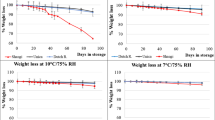Summary
Sugar disappearance during reconditioning of cold-stored (1,2 and 6°C) Polish potato varieties and strains was investigated. A high sugar level usually increased the rate of sugar loss during subsequent reconditioning, though there were some exceptions. Comparison of two reconditioning temperatures (20 and 30°C) showed that the higher temperature did not increase the rate of sugar loss and because of higher total losses it is not recommended for practical use.
Zusammenfassung
Es wurden einige polnische Kartoffelsorten und-stämme auf den Rückgang der Zucker während der Rekonditionierung kühlgelagertes Materials untersucht. Rekonditionierung bei 20°C und 30°C wurde nach einer angemessenen Periode der Kühllagerung bei 1, 2 und 6°C angewendet. Gesamtzucker, reduzierende Zucker, Saccharose, Glukose und Fruktose wurden bestimmt.
Es wurde festgestellt, dass der Stand der angehäuften Zucker während der Kühllagerung einen ausgesprochenen Einfluss auf den Zuckerverlust während der nachfolgenden Rekonditionierung hatte: je höher der Zuckergehalt in den Kartoffelknollen, um so rascher sein Verlust während der Rekonditionierung (Abb. 1–5).
Die Knollen der verschiedenen Sorten (Stämme) können auf Grund ihrer Zuckeranhäufung während der Kühllagerung und ihres Verlustes während der nachfolgenden Rekonditionierung in drei Kategorien eingeteilt werden: 1) Sorten, die während der Kühllagerung rasch Zucker anhäufen und während der Rekonditionierung rasch Zucker verlieren; 2) Sorten mit rascher Zuckeranhäufung während der Kühllagerung und langsamen Zuckerverlust während der Rekonditionierung; 3) Sorten mit langsamer Zuckeranhäufung während der Kühllagerung und ziemlich raschem Zuckerverlust während der Rekonditionierung, wie bei den Sorten Wulkan, Flisak und Nina (Abb. 6–10). Die Knollen der ersten und dritten Kategorie sind für die Industrie geeignet.
Wegen des tiefen Zuckerspiegels nach der Lagerung bei 6°C ist eine Rekonditionierung nicht nötig, obwohl in einigen Fällen das Material verbessert werden kann, besonders in Bezug auf reduzierende Zucker (Abb. 2). Für Knollen, die bei 2°C gelagert wurden, wird eine Rekonditionierung von mindestens 4 Wochen empfohlen, wenn sie für die technische Verarbeitung geeignet sein sollen. Die Rekonditionierung sollte bei Knollen, die bei 1°C gelagert wurden, sogar noch verlängert werden.
Die Anwendung einer Temperatur von 30°C für die Rekonditionierung beschleunigt die Zuckerabnahme nicht (Tab. 1). Wegen der gesteigerten Gesamtverluste (2–3 mal grösser als bei Rekonditionierung bei einer Temperatur von 20°C) kann diese Temperatur für den praktischen Gebrauch in der Industrie nicht angewendet werden.
Résumé
Plusieurs variétés et hybrides polonais de pomme de teire ont été examinés quant à la disparition des sucres au cours de reconditionnement de matériel conservé au froid. Le reconditionnement à 20 et 30°C a été effectué après des périodes identiques de conservation à 1, 2 et 6°C. Sucres totaux, sucres réducteurs, sucrose, glucose et fructose ont fait l'objet de déterminations.
Il se révèle que la quantité de sucres accumulés pendant la conservation au froid a une influence prononcée sur la perte en sucres pendant le reconditionnement subséquent: plus élevée est la quantité de sucres dans les tubercules, plus rapide est la perte durant le reconditionnement (fig. 1–5).
Les divers variétés et hybrides peuvent être groupés en trois catégories sur la base de l'accumulation des sucres dans leurs tubercules pendant la conservation au froid et la disparition de ces sucres au cours du reconditionnement subséquent: 1) les variétés accumulant rapidement des sucres pendant la conservation au froid et perdant rapidement les sucres pendant le reconditionnement; 2) les variétés accumulant rapidement des sucres pendant la conservation au froid et perdant lentement les sucres pendant le reconditionnement; 3) les variétés accumulant lentement des sucres pendant la conservation au froid et présentant une décomposition moyennement rapide des sucres durant le reconditionnement, comme c'est le cas chez les variétés Wulkan, Flisak et Nina (fig. 6–10). Les tubercules des première et troisième catégories conviennent pour l'industrie.
Le reconditionnement n'est pas nécessaire lorsque la quantité de sucres est faible après conservation à 6°C, bien qu'il arrive que le matériel doive être amélioré, spécialement pour les sucres réducteurs (fig. 2). Pour être utilisables dans les industries de transformations, les tubercules conservés à 2°C doivent subir un reconditionnement de 4 semaines. La période de reconditionnement devrait être allongée dans le cas de tubercules conservés à 1°C.
Une température de reconditionnement de 30°C n'accentue pas la vitesse de disparition des sucres (tableau 1). En raison des pertes totales élevées (2 à 3 fois plus élevées que lors du reconditionnement à 20°C), la température de 30°C ne peut pas être recommandée dans la pratique industrielle.
Similar content being viewed by others
References
Müller-Thurgau, H., 1882. Über die Natur des in süssen Kartoffeln sich vorfindenen ZuckersLondw.Jb. 11: 751.
Pokrovskaya, M. Z., 1966. The influence of storage temperature on biochemical changes of carbohydrates in potato tuber. (Russian.)Proc. 2nd Int. Congr. Fd Sci. Technol. Storage Fd Prod. (Doklady, Moskva. 1966).
Samotus, B., M. Niedźwiedź, Z. Kolodziej, M. Leja & B. Czajkowska, 1974. Storage and reconditioning of tubers of Polish potato varieties and strains. 1. Influence of storage temperature on sugar level in potato tubers of different varieties and strains.Potato Res., 17: 64–81.
Samotus, B. & M. Palasiński, 1964. Transformations of carbohydrates in potato tubers after transferring them from low to high temperatures of storage. (Polish: English summary.).Zeszyty Naukowe WSR Kraków No 20: 81–97.
Author information
Authors and Affiliations
Additional information
This work was supported in part by the U.S. Department of Agriculture, Grant No. FG-Po-233.
Rights and permissions
About this article
Cite this article
Samotus, B., Niedźwiedź, M., Kolodziej, Z. et al. Storage and reconditioning of tubers of Polish potato varieties and strains. 2. Changes in sugar level in potato tubers of different varieties and strains during reconditioning of cold-stored potatoes. Potato Res 17, 82–96 (1974). https://doi.org/10.1007/BF02361871
Accepted:
Issue Date:
DOI: https://doi.org/10.1007/BF02361871




